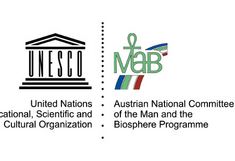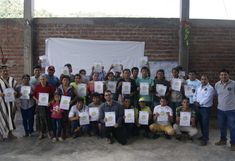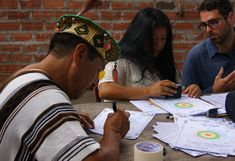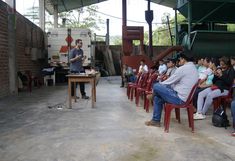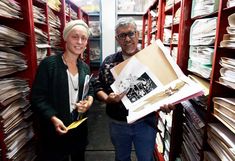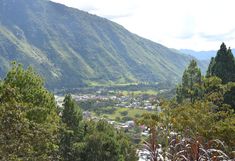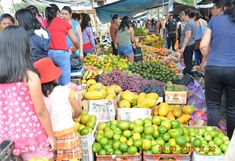„Lessons Learned for the Management Policy of the Biosphere Reserve “Oxapampa-Asháninka-Yanesha” (Peru) based upon the inhabitants’ local knowledge and available global scientific knowledge"
A project funded by the Austrian Academy of Sciences (UNESCO Man and Biosphere Programme)
As early as 1973, two years after the MAB program was founded at UNESCO, the Austrian MAB National Committee was established on the basis of a contract with the Ministry of Science and Research at the Austrian Academy of Sciences (ÖAW). Austria is therefore one of the first countries to participate in the UNESCO MAB program.
The aim of the National Committee is to steer and coordinate MAB research in Austria. It observes the Austrian research landscape, analyzes research needs, formulates new research strategies and stimulates and finances research projects. The National Committee advises and supports those responsible for scientific and technical issues in the biosphere parks and provides the link to the MAB Secretariat in Paris. In addition, it is responsible for submitting an area to UNESCO as a biosphere park and for compliance with UNESCO requirements.
Currently ongoing
To commemorate the 10th anniversary, we edited the book: “Diez años de la Reserva de Biósfera Oxapampa-Asháninka-Yánesha (BIOAY): Testimonios, reflexiones y logros”. The publication covers the history of the BIOAY, experiences, current research results, and interviews with indigenous inhabitants of the BIOAY in the four languages of the BIOAY: Asháninka, Yánesha, Quechua and the Austro-German dialect of Pozuzo.
Albarracín-Llúncor, Gabriela & Vogl, Christian Reinhard (2021): Diez años de la reserva de biosfera Oxapampa – Asháninka – Yánesha BIOAY: testimonios, reflexiones y logros. Universität für Bodenkultur Wien / University of Natural Resources and Life Sciences, Vienna, Austria. ISBN-Online: 978-3-7001-8507-9.
Open Acess: https://www.austriaca.at/?arp=0x003c38c6
Selected experiences 2020
June 2020
The Biosphere Reserve Oxapampa – Asháninka – Yánesha celebrates its 10th anniversary on June 2nd 2020. Due to the travel restrictions, the celebration was done online. You can follow the presentations online: Facebook Oxapampa
February 2020
Moritz Egger, BOKU master's student, presented the first results of his research on the topic: “SMART sustainability analysis in organic coffee production” in the indigenous community of Ñagazu (Peru).
Local representatives of the Oxapampa Ashaninka Yanesha biosphere reserve were present, including the “Kornesha”, head of the Yanesha communities.
The public workshop served as a framework to discuss the results of M. Egger's investigation. Ways should be found to incorporate these results into the local management of coffee plantations. The dialogue between the various interest groups is essential to jointly develop strategies to meet sustainability challenges in the value chain for organic coffee.
The workshop was moderated by the cooperative "Villa Rica Golden Coffee". Local coffee farmers, village chiefs, the Association of Sustainable Yanesha Producers (APSY), the Federation of Yaneshas Native Communities (FECONAYA) and the Ministry of Culture were also involved.
January 2020
Eva Arhar has just returned from the biosphere reserve. She carried out research work for her master's thesis there in 2019. Her work is concerned with how crop diversity affects the diversity of the food of urban residents in Oxapampa.
During the field research, consumers, local vendors in markets and shops, restaurant owners and farmers were interviewed. Eva studied whether / how the local crop diversity in the area of Oxapampa is reflected in the diet, in the range of markets / shops or in the preparation of food in Oxapampa.
During the field research Eva got to know a variety of different people who live in Oxapampa or its immediate surroundings. She especially remembered the Kemito chocolate factory. Chocolate is produced there by a Peruvian woman who has only recently returned from Germany to her home village. Cocoa beans are bought and processed by an indigenous community deep in the rainforest. The goal is to support and promote the residents of this community.
Selected experiences 2019
Selected experiences 2019
Gabriela Albarracin has been in Oxapampa for her feld research and for advancing our tasks in 2019.
Viviane Griesinger was working in the biosphere reserve for her master thesis in 2018/2019. Viviane is a geographer and meanwhile already finished her studies on environmental and bioresource management at BOKU. She was writing her master's thesis on "Interaction between global biosphere research and local resource management" in the Oxapampa-Yánesha-Asháninka Biosphere Reserve. She was supported in her research by the Service of Natural Protected Areas (SERNANP) in Oxapampa.
Background
Within and around the Biosphere Reserve Oxapampa Ashaninka Yanesha (RBOAY) at the small plots of subsistence oriented family farms and in their neighborhood a high agricultural genetic diversity of crops along with a rich diversity of associated organisms can be found (Yarupaitán & Antezano, 2016). Besides the importance of this diversity for ecosystems, high biodiversity contributes to the sustainability of agricultural production systems and food security (Segnon & Achigan-Dako, 2014). Nevertheless, an improved understanding of the synergies between natural and managed landscapes is crucial for preserving traditional sustainable land management systems and channeling benefits to RBOAY communities that maintain resilient landscapes and biodiversity (comp. Scherr & McNeely, 2008).
About the biodiversity of the many studies have been realized already! They are published and enrich global knowledge. But are the results available for the RBOAY management or for local people? Does this global knowledge benefit local stakeholders? Is it available in the study area in an accessible form?
Our answer is: “No!”
Aims
Our project focus here is not adding new primary data but making accessible locally the results of a meta-analysis of internationally and nationally, available data not yet sufficiently integrated into the RBOAY management policies.
Thus, our aim is building bridges between the available global scientific knowledge about the RBOAY and local knowledge within the RBOAY.
In our project we are implementing an inter-disciplinary assessment and meta-analysis of already available data on agrobiodiversity conservation and other research topics that took RBOAY as study site.
Thus, we are presenting locally accessible, well designed, carefully tested answers in the form of high quality media (video, audio, posters) that can be used by local stakeholders for their efforts in promoting sustainability in the RBOAY.
The project outcomes might reveal strategies and options that can be applied in a range of settings to manage the expanded areas under protection, both in Peru and in protected area systems globally.
The project uses the concept of interdisciplinary research that will respond to the increasing urgent global imperatives to conserve both cultural and biological diversity as urged by the Convention of Biological Diversity UNESCO's 'Man and Biosphere Programme' and the Declaration on the Rights of Indigenous People.
The link between Austria and Peru
The study area RBOAY and Austria show some unexpected links: Austrians from the Province of Tyrol migrated to that area in 1859. The interest of Austria, especially citizens of the Province of Tyrol, in that area is therefore remarkably high.
The underlying objective for this proposal is therefore intensifying the Austrian-Peruvian interaction, exchange of experiences and capacity building on the sustainable management of bio-culturally diverse areas, as expressed by the Sevilla Strategy.
Key words
Keywords: Organic farming; Agroecology; Agricultural policy; Sustainable agriculture; Empirical social research; Ethnology; Regional development;Knowledge management; agrobiodiversity; ethnobotany; rural development
Publications from previous projects with relation to AGROBIO-K_NOW
[Translate to English:]
- GRASSER,S., C. SCHUNKO, C. R. VOGL (2016): Children as ethnobotanists: methods and local impact of a participatory research project with children on wild plant gathering in the Grosses Walsertal Biosphere Reserve, Austria. Journal of Ethnobiology and Ethnomedicine 12 (46)
- SCHUNKO, C; GRASSER, S; VOGL, C. R. (2015): Explaining the resurgent popularity of the wild: motivations for wild plant gathering in the Biosphere Reserve Grosses Walsertal, Austria.J ETHNOBIOL ETHNOMED. 2015; 11:55
- GRASSER, S; SCHUNKO, C; VOGL, C.R (2012): Gathering "tea" - from necessity to connectedness with nature. Local knowledge about wild plant gathering in the Biosphere Reserve Grosses Walsertal (Austria). Ethnobiology and Ethnomedicine; 8:31 doi.org/10.1186/1746-4269-8-31
- SCHUNKO, C; GRASSER, S; VOGL, C. R. (2012): Intracultural variation of knowledge about wild plant uses in the Biosphere Reserve Grosses Walsertal (Austria). Ethnobiology and Ethnomedicine. 8: 23 doi.org/10.1186/1746-4269-8-23
- GRASSER, S.; C. R. VOGL; C. SCHUNKO; M. GRABOWSKI; T. VOGL und B. VOGL-LUKASSER (2012): Biokulturelle Vielfalt. Vom Lokalen Erfahrungswissen zu Pflanzen im Biosphärenpark Großes Walsertal. Endbericht zum Forschungsprojekt "Monitoring of Biocultural Diversity in the Biosphere Reserve Großes Walsertal, Austria. The use and management of biodiversity of crops, cultivars and wild gathered plant species.". Gefördert vom "Man and Biosphere (MAB)" - Programm der Österreichischen Akademie der Wissenschaften., Eigenverlag. Department für Nachhaltige Agrarsysteme, Universität für Bodenkultur Wien.
- Haselmair, Ruth Mag.a. (2012): Weitergabe und Tradierung von Wissen über Kulinarik in der österreichisch-deutschen Siedlung Pozuzo in Peru. Supervisors: Christian R. Vogl (DNAS/BOKU), Ernst Halbmayr (Institut für vergleichende Kulturforschung, Faculty of Social Science and Philosophy, Philipps-Universität Marburg)
- HASELMAIR, R., H. A PIRKER, E. KUHN AND C. R. VOGL (2014): Personal networks: a tool for gaining insight into the transmission of knowledge of food and medicinal plants among Tyrolean (Austrian) migrants in Australia, Brazil and Peru. J ETHNOBIOL ETHNOMED, 10:1. doi: 10.1186/1746-4269-10-1.
- PIRKER, H; HASELMAIR, R; KUHN, E; SCHUNKO, C; VOGL, C. R. (2012): Transformation of traditional knowledge of medicinal plants: the case of Tyroleans (Austria) who migrated to Australia, Brazil and Peru. Ethnobiology and Ethnomedicine; 8(1):44-44. Highly Accessed.
- KUHN E.; PIRKER, H.; HASELMAIR, R.; VOGL C. R. (2012): Tirolerknödel in aller Welt. Veränderung von kulinarischem Wissen Tiroler Migranten und Migrantinnen in Peru, Brasilien und Australien In: Tiroler Heimatblätter, 87 (1), 32-38, Tyrolia Verlag, Innsbruck
- PIRKER, H.; KUHN, E.; HASELMAIR, R.; VOGL C. R. (2012): Wissen über Heilpflanzen bei Tiroler Migrant_innen und ihren Nachfahren in Australien, Brasilien und Peru In: Tiroler Heimatblätter, 87 (2), 66-73, Tyrolia Verlag, Innsbruck
- HASELMAIR, R; PIRKER, H; KUHN, E; VOGL C:R. (2011): Veränderung von Wissen bei Tiroler Auswanderern in Peru, Brasilien und Australien. Teil 2: Palmbuschen - Tiroler Brauch fern von Tirol. Tiroler Heimatblätter, 86 (2), 76-80
- KUHN, E; PIRKER H; HASELMAIR R; VOGL C.R. (2011): Veränderung von Wissen bei Tiroler Auswanderern in Peru, Brasilien und Australien. Teil 1: Einführung - Projektvorstellung. Tiroler Heimatblätter, 86 (1), 2-7

